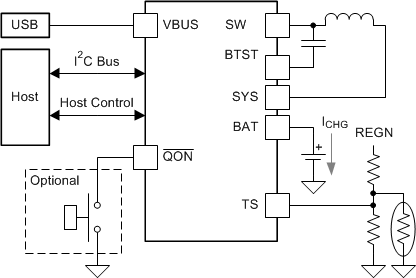ZHCSGA3A march 2017 – march 2023 BQ25601
PRODUCTION DATA
- 1 特性
- 2 应用
- 3 说明
- 4 Revision History
- 5 说明(续)
- 6 Device Comparison Table
- 7 Pin Configuration and Functions
- 8 Specifications
-
9 Detailed Description
- 9.1 Overview
- 9.2 Functional Block Diagram
- 9.3
Feature Description
- 9.3.1 Power-On-Reset (POR)
- 9.3.2 Device Power Up from Battery without Input Source
- 9.3.3 Power Up from Input Source
- 9.3.4 Boost Mode Operation From Battery
- 9.3.5 Host Mode and Standalone Power Management
- 9.3.6 Power Path Management
- 9.3.7 Battery Charging Management
- 9.3.8 Protections
- 9.4 Device Functional Modes
- 9.5 Programming
- 9.6 Register Maps
- 10Application and Implementation
- 11Power Supply Recommendations
- 12Layout
- 13Device and Documentation Support
- 14Mechanical, Packaging, and Orderable Information
3 说明
BQ25601 是一款高度集成的 3A 开关模式电池充电管理和系统电源路径管理器件,适用于单节锂离子和锂聚合物电池。其低阻抗电源路径对开关模式运行效率进行了优化、缩短了电池充电时间并延长了放电阶段的电池使用寿命。具有充电和系统设置的 I2C 串行接口使得此器件成为一种真正灵活的解决方案。
器件信息
| 器件型号 | 封装(1) | 封装尺寸(标称值) |
|---|---|---|
| BQ25601 | WQFN (24) | 4.00mm x 4.00mm |
(1) 如需了解所有可用封装,请参阅数据表末尾的可订购产品附录。
 简化版应用
简化版应用